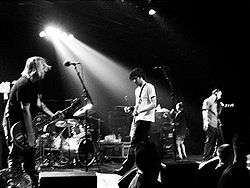Melodic hardcore
| Melodic hardcore | |
|---|---|
| Stylistic origins | |
| Cultural origins | Early 1980s, California and Washington, D.C., United States |
| Typical instruments | |
| Derivative forms | Skate punk |
| Other topics | |
Melodic hardcore is a broadly defined subgenre of hardcore punk with a strong emphasis on melody in its guitar work. It generally incorporates fast rhythms, melodic and sometimes distorted guitar riffs, and vocal styles tending towards shouting and screaming. Nevertheless, the genre has been very diverse, with different bands showcasing very different styles. Of the pioneering melodic hardcore bands such as Bad Religion and Descendents, some have proven influential across the spectrum of punk rock, as well as rock music more generally.
History

Original development (1980s–1990s)
The earliest melodic hardcore emerged from the Californian hardcore punk scene by the early 1980s. This includes Descendents, who formed in 1978. Their earliest work was simple, pop-influenced punk rock, but they went on to mix this melodic approach with hardcore, inspiring both melodic hardcore and pop punk groups.[1] Bad Religion, who formed in Los Angeles in 1979, played in a somewhat similar vein, but their approach was more "angry" and politically charged.[2] They recorded their debut album, How Could Hell Be Any Worse?, in 1981.[3]
The Faith's 1983 EP Subject to Change is thought of as one of the first melodic hardcore records, as significant as the music of Bad Religion or the Descendents.[4] On the release, the band added and moved away from the more straightforward hardcore punk of their earlier work towards a more complex, textured, and melodic sound, accompanied by introspective lyrics; the release is notable for its influence on post-hardcore.[5]
Dag Nasty are a key melodic hardcore band[6] that formed during the mid-1980s as part of the Washington, D.C. hardcore scene, with Brian Baker (ex-Minor Threat) on guitar. Their sound was, to a degree, a development on Minor Threat's album Out of Step. In 1988, the band All formed, featuring three members of the now disbanded Descendents. The band made music in a broadly similar vein to the Descendents, and were initially fronted by Dave Smalley of Dag Nasty.[3] Gorilla Biscuits came out of the late 1980s New York hardcore scene, and played a melodic form of the hardcore subgenre known as youth crew. Youth crew itself takes a lot of influence from 7 Seconds, who ventured into melodic hardcore on albums such as The Crew. Turning Point, a New Jersey hardcore band, also emerged from the youth crew movement, but their later material moved towards melodic hardcore, with more complex music and introspective lyrics.
Melodic hardcore developed into a large and diverse genre by the 1990s, pushed by bands such as Bane who took on post-hardcore influences. Lifetime was a notable melodic hardcore group whose sound drew also on pop punk and emo. Along with other melodic hardcore groups, they had much influence on subsequent pop punk, including bands such as Fall Out Boy and Saves the Day. When Lifetime broke up, some of their members formed Kid Dynamite, with a more aggressive take on melodic hardcore. During the 1990s, the "Epi-Fat" sound (a variant of pop punk named after the labels that housed its key bands, Epitaph Records and Fat Wreck Chords) was popular, and key bands such as NOFX and Strung Out bordered on melodic hardcore influenced by the likes of Descendents and Bad Religion.

Modern melodic hardcore (2000s–present)
Rise Against, formed in 1999, achieved widespread commercial success with the release of their major label debut Siren Song of the Counter Culture in 2004. After about 2005, the genre transformed through the work of newly formed American bands including Killing the Dream, Modern Life Is War, The Hope Conspiracy, Comeback Kid (from Canada), Sinking Ships, Have Heart, Verse, The Carrier, Ruiner, and This Is Hell, many of them housed by key hardcore labels Bridge 9 Records and Deathwish Inc.[6] Thereafter by about 2009, "the likes of Defeater, Touché Amoré, the Ghost Inside, Counterparts, Being as an Ocean and many more became the new faces of melodic, emotional hardcore",[6] creating an overlap with post-hardcore and metalcore in current melodic hardcore.
References
- ↑ "Descendents were the model for all 'melodic' HC that followed." Blush, Steven and Petros, George; American hardcore: a tribal history; Los Angeles: Feral House: Distributed by Publishers Group West, 2001. OCLC 48658495. Part Two. "LA: How Could Hell Be Any Worse?" p. 79.
- ↑ Peter Jandreus, The Encyclopedia of Swedish Punk 1977–1987, Stockholm: Premium Publishing, 2008, p. 11.
- 1 2 American Hardcore, p. 80.
- ↑ "Faith Subject to Change and First Demo". Drowned in Sound. 2011-09-26. Retrieved 2012-08-11.
- ↑ "Faith/Void Split". Sputnikmusic. 2011-06-05. Retrieved 2012-08-11.
- 1 2 3 Kraus, Brian (June 22, 2014). "16 Modern Precursors Of Melodic Hardcore". Alternative Press. Retrieved April 4, 2016.
Further reading
- Sharpe-Young, Garry, New wave of American heavy metal, New Plymouth, New Zealand: Zonda Books, 2005. OCLC 71843078
- Larkin, Colin, The Guinness encyclopedia of popular music; Enfield, Middlesex, England: Guinness Pub. ; New York: Stockton Press, 1995. OCLC 32949294
- Budofsky, Adam ; Heusel, Michele; Dawson, Michael Ray and Parillo, Michael, The drummer: 100 years of rhythmic power and invention; Cedar Grove, NJ: Modern Drummer Publications ; Milwaukee: Exclusively distributed by Hal Leonard Corp., 2006. OCLC 65063692